It seems that plants are always teaching me new lessons about how they behave in the garden and respond to weather and other conditions. This summer, there are three native plants that have been on my mind.
First, Yellow Coneflower (Ratibida pinnata). I’m fond of this plant with its central cone like a clown’s nose and bright yellow yet droopy ray flowers. In rich garden soil, though, it tends to grow too tall (5′ or more) and flop. To limit this tendency I use tall tomato cages.
This year it’s growing even taller than usual – over 6′. It must like this year’s hot summer, despite the lack of rain (though I have done some occasional watering). My takeaway: I really need to cut this plant back in late spring. I’ve been told that you can also cut it back in late summer after it blooms and you’ll get another round of flowers. I’ll try that.
Also, it’s starting to self-sow pretty aggressively, which for some reason it didn’t seem to do for the first few years. Now it’s popping up a fair amount, so I think I’ll have to start editing it out. I suspect Yellow Coneflower performs better in a leaner soil and with more competition.
Next up: Hoary Vervain (Verbena stricta). This is another plant I like a lot, though I object to the name. Sounds like a character from Lord of the Rings. “To find the Ring, you must first seek out the Hoary Vervain.”
So here’s what I’ve learned about Hoary Vervain. First off, it will self-sow. A lot. BUT it will not compete with taller plants. Which means that in the Driveway Border, it self sows only along the edge, which is supposed to be covered with various low, mounding plants. Plants so often refuse to cooperate with my design ideas.
Hoary Vervain is normally upright but here it is leaning at a distinct angle, I suspect to get away from the tall plants that are blocking the morning sun. They do get full afternoon sun. Or it could be the rich soil that causes it to grow extra tall and lean. (Though I don’t fertilize this border but only allow the plant debris to decompose.) The Hoary Vervain also, I suspect, would be performing better if they had been cut back in May.
I will say, though, that the Hoary Vervain seems unbothered by this summer’s heat and dryness.
Finally, Aromatic Aster (Symphyotrichum oblongifolium – the botanical name is a real mouthful!). This plant is at the far end of the Driveway Border, facing west. My idea is that it would provide a low mound of blue blooms in fall. And it has, although it tends to grow bigger than I expected.
Aromatic Aster likes full sun and drier soils but this year it is showing signs of stress, with some stems turning brown. These I have tried to prune out. The heat of the afternoon sun is intensified by the pavers in our driveway. My lesson learned, which I guess sounds pretty obvious, is that Aromatic Aster can suffer in just moderate drought if it sits in a challenging microclimate. In these circumstances it needs supplemental watering to look good.
These days it’s hard not to look at the garden and think how I would have done things differently if I knew then what I know now. Certainly, rich soil can be a mixed blessing, unless you are growing food crops. Though I have always loved tall plants, and that has not changed. Gardeners must live and learn, because we are working with living things that react to their environment in dynamic ways. But that is part of the fun.

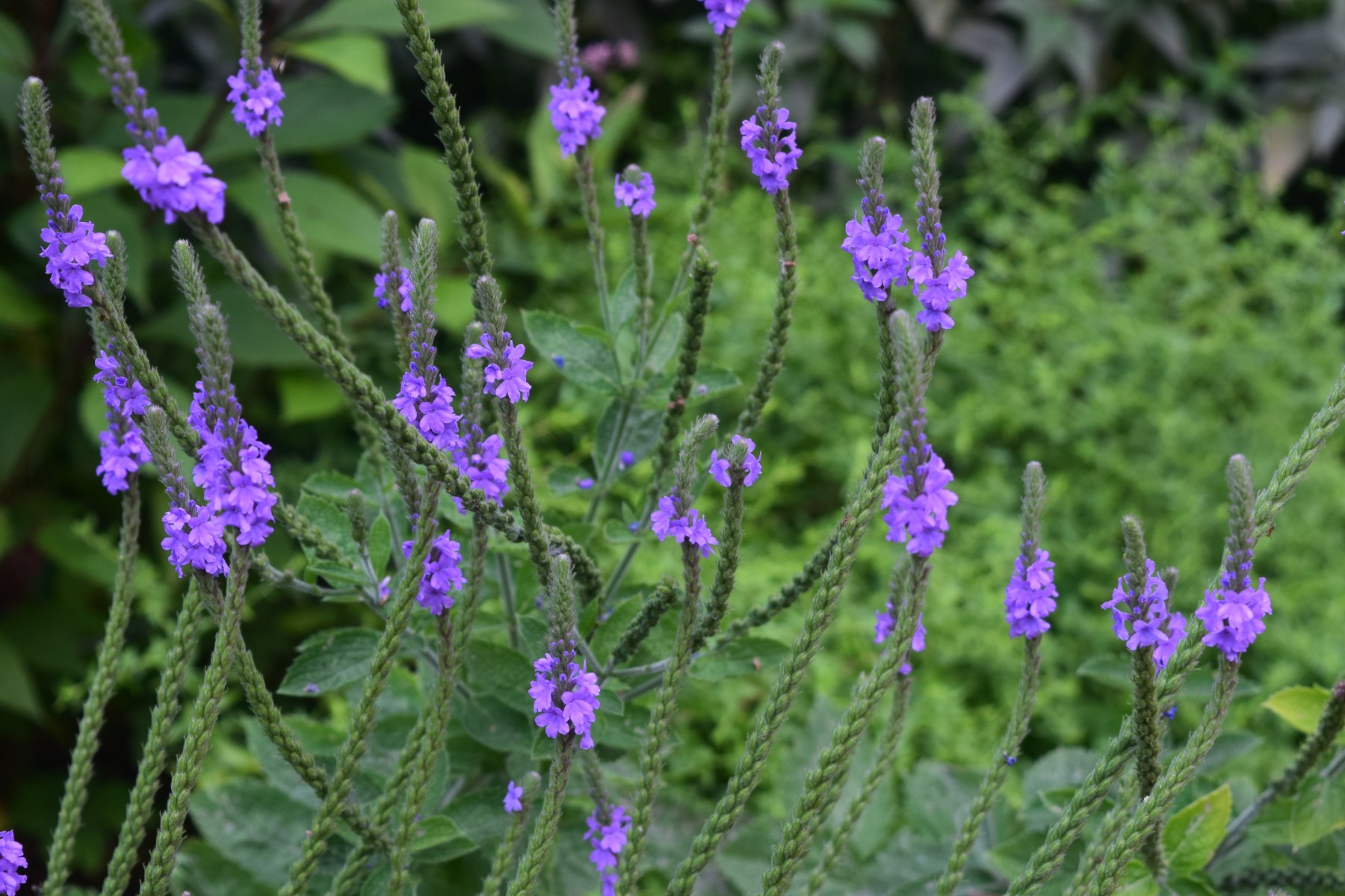
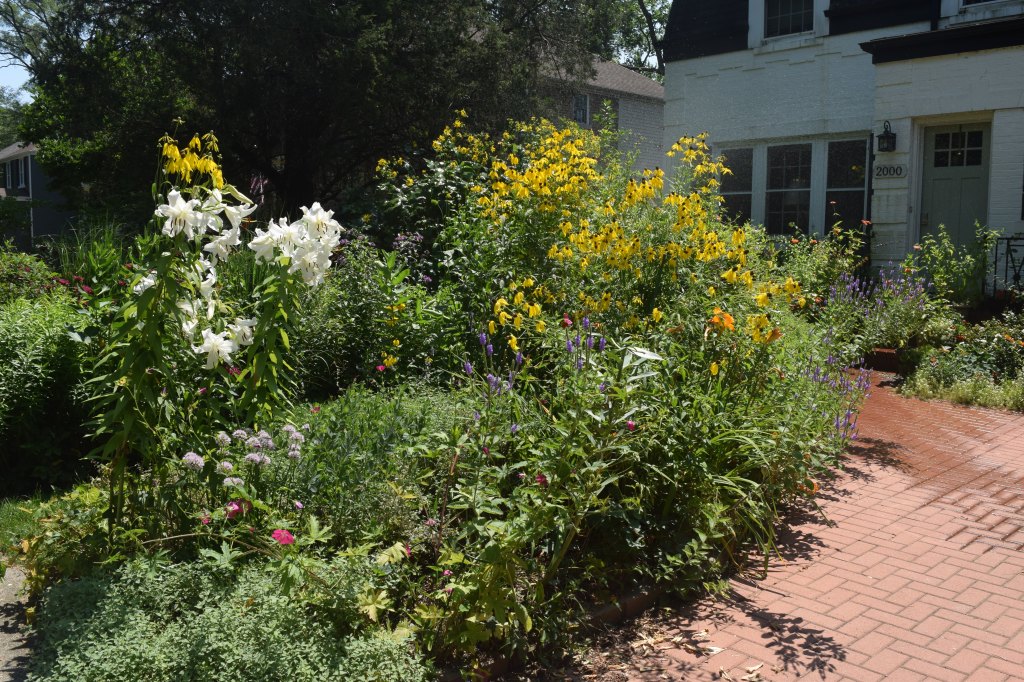

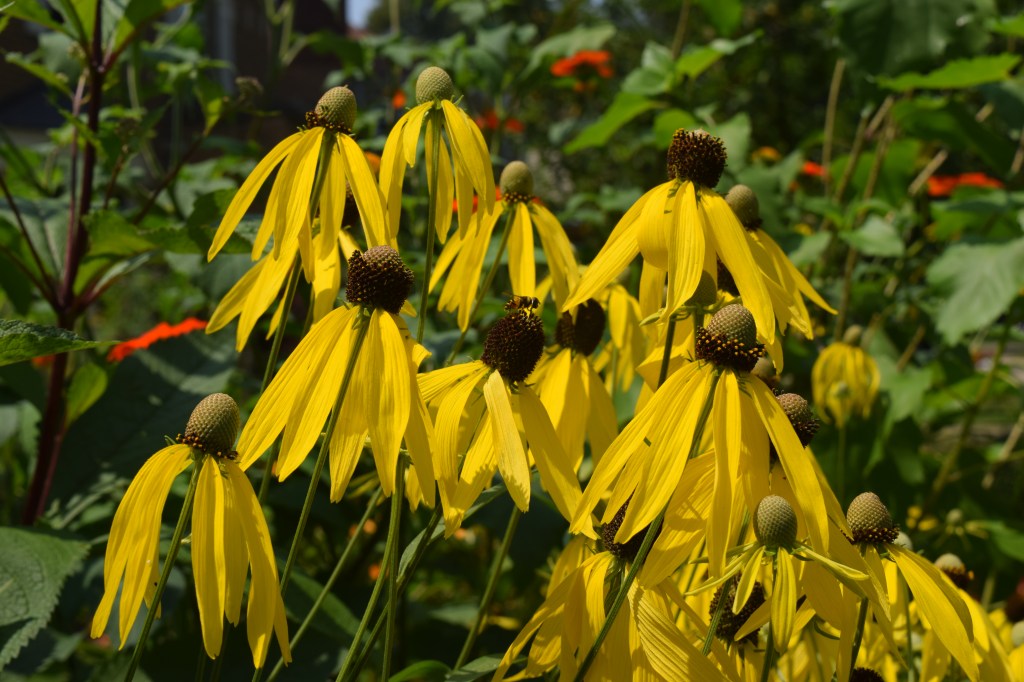
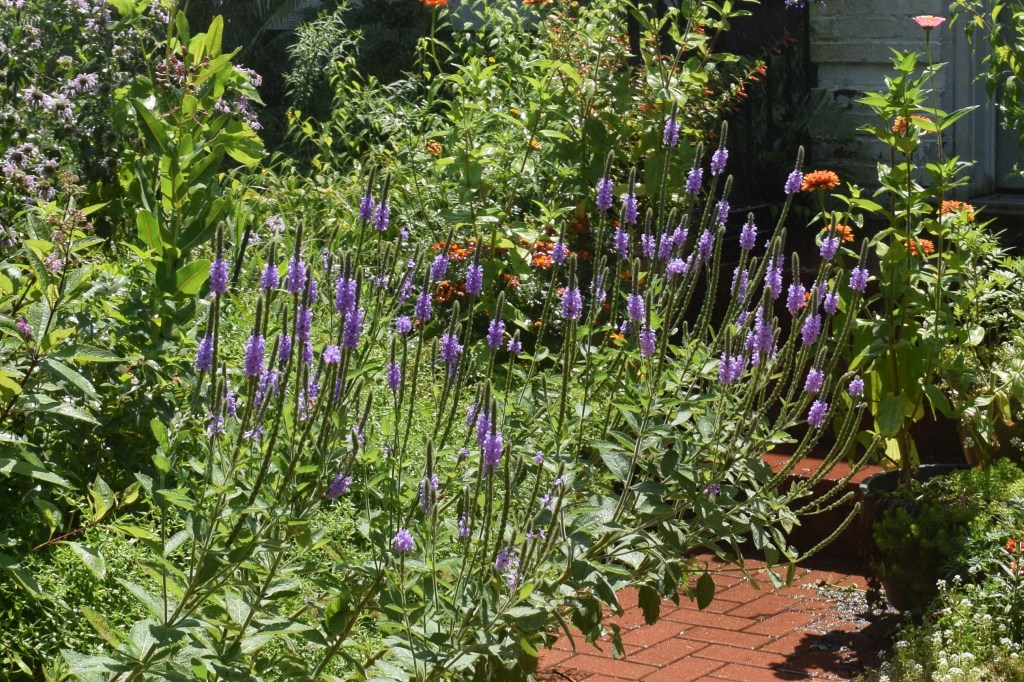
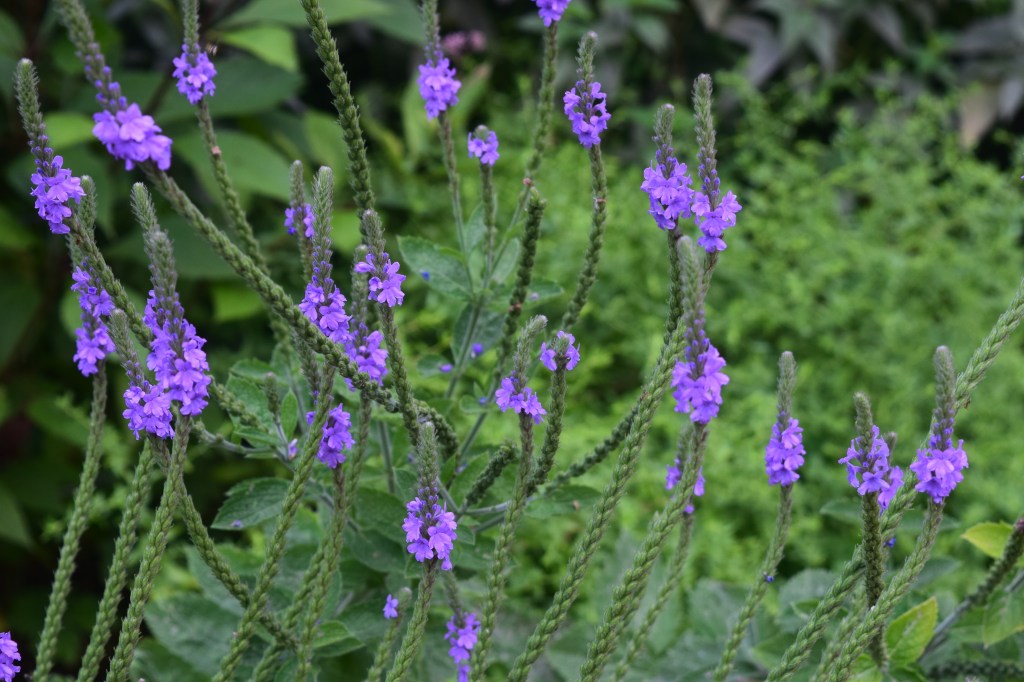






Ah, but isn’t that the case with most of life? If only I had known then what I know now.
At least with gardening you can usually start over if so inclined. 😺
Lots of great advice. I love the Aromatic Aster. I have a low aster that blooms late into the fall and is very energetic. I have it planted on our hugel which has lots of room and few plants that like the hugel.
What’s a hugel?
Even where we have large spaces for big plants, I find them to be intimidating. As you know, and demonstrate here, there are always some that get bigger than expected, even if others do just the opposite. We sometimes need to relocated those that perform a bit too well from their refined landscapes to unlandscaped areas. It sometimes works out well, but I am hesitant about the potential for something to escape into the wild. Recently, I have considered doing something backward, by relocating the naturalized perennial pea ‘into’ a landscape! Wow, that is a stretch. I often need to kill perennial pea that comes up in landscapes, and it is nearly impossible to kill. Do I really want to move some ‘into’ a landscape? Well, they are white, and white ones are rare. The particular landscape is not too refined.
Absolutely! Gardening is a fascinating challenge, a dance between what the plants want and what the gardener wants. Sometimes, gardeners must adjust their expectations. Many times, in my case.
Ditto.
It seems to me that nothing — in or out of the garden — is the usual these days. There are times we seem to grow only surprises. By the way, I have had a nightmare summer with rabbits this year, and I’ve leaned on your suggestion to use Irish Spring. It hasn’t worked miracles, but I think it has helped some. I took some pathetic plant remnants, chewed to smithereens, and replanted them in pots, tended them obsessively, and rubbed Irish Spring on the outside and rim of the pots. So far I think maybe it’s helping. No incontrovertible evidence yet, but I send thanks!
I hope it works. Consensus from people I know is that it helps but not totally.
I giggled about your thoughts regarding your ‘garden designs’. I am always designing and then the plants do what they want. I need more asters in my garden. The ones I have don’t do well do to not enough sun so I might just not pursue that design idea. This is the first year that my yellow coneflower has really grown good. Third year syndrome I believe, but I must say I was sad at how it flops. I am glad to know that someone elses flops too. Next year I will be ready for them…if I remember next spring.
Nice article. I think I will go out and cut back part of my coneflower behemoth, and see what happens. Then I will try to remember whatever lesson that teaches me for next year!
Good luck.
My Prairie coreopsis, liatris and other natives also grow to gigantic proportions. let’s remind each other next spring to cut them back and see if that brings them back to our level.
Can you cut back Liatris? I didn’t know.
Plants are always throwing unexpected curves at us, aren’t they?! All three of your native plants are lovely and I hope you find ways to manage them. I’m dealing with a native aster now that spreads via rhizomes but was billed as manageable in low water gardens. Well, we’ve been dealing with drought off and on (mostly on) for years but it took just one year of above average rain to run amok and now I’m looking at lots of dry, burned stems as we’ve descended back into severe drought 😦
Ugh, I’m sorry.
Nice set of plants and they sure bring lots of color to your garden. I think Hoary Vervain was supposed to travel with the 9, but got lost…
I grow the same fall aster; mine doesn’t usually bloom until October-ish. It’s always handled our hot summers well, in fact, I usually have to prune by half in late June or July.
I’m beginning to wonder if there’s some disease and it’s not the heat/drought.
I love these three beauties! I know from experience that the vervain is a vigorous reseeder. I now deadhead them so I don’t need to weed out 1000s of them in the spring. I think even if we knew all we have learned from day one of our gardening life, we’d still have plenty of blunders. Don’tcha think?
Undoubtedly true.
What a lovely post and a perfect read along with breakfast.
I’ve found that lessons learned from plants sink in deeper and are rarely forgotten, so I enjoy learning from them.
You’ve given a name to an aster in a local park that I’ve wondered about for years. I’ll have to smell it next time I go there.
Although our plants and seasons are different, I know exactly what you mean when you write “if I knew then, what I know now”… oh so true. Overall the plants in our garden keep me guessing, and I’ve learnt to buy local because our climate is so varied. A good topic for discussion.
I especially like the look of those asters. And I believe you hit the nail on the head for many gardening problems I have too with ‘Plants so often refuse to cooperate with my design ideas’! We all live and learn, and like you say, that is part of the fun! 😃
Lovely plants, hoary vervain reminds me of my verbena bonariensis that self seeds too. Perhaps we should start an unfair name list. My favourite wild flower over here is called bastard balm. How unfair is that? Amelia
Bad plant names is one of my pet peeves. Whatever inspired someone to name a Hydrangea variety ‘Pinky Winky’?
Your plants are happy, happy. They probably know they are much appreciated and valued. 🙂
Your coneflower reminds me of our Texas coneflower: Rudbeckia texana, a native that can easily reach 8′ in height. I find small colonies of them occasionally, but never have seen one ‘flop.’ It’s interesting that Rudbeckia and <Ratibida are considered synonyms; it took me a while to find your yellow coneflower in my books, but I finally sorted it out on the Wildflower Center site.
If your asters had the same growth habit as some of our natives, they’d be in the dining room by now. It’s interesting that the pavers seem to have created a microclimate for them, although it makes sense.
Looking fab👏 Didn‘t know aromatic aster but I love all of them. Have been intrigued by how they hybridize. Have you noticed this as well?
Not so much with Asters, though many species are so similar it may be hard to tell, but definitely with Monardas.
Yeah, sure you might do it differently if you did it over, but it sure looks good now! Be grateful you didn’t spend 15 years looking at lawn before diving in.
The brick pavers are really looking good with everything settling in around them.
Your garden is so lush and amazing!! I feel like nestling under one of those plants and having a little nap. The yellow coneflower is so tall! I was unfamiliar with that variety. The vervain is a beauty and I wish we had it in our garden. Do you get butterflies on the asters? I’m enjoying your blog very much. -lisa
Not butterflies so much but lots of bees.
Yes, if only we knew then what we know now! I do love that yellow coneflower, it’s such a majestic plant. Hoary Vervain…what a name!xxx
I’ve tried growing hoary vervain as bare root plants in the fall and plugs in the spring and none of them have survived. Sounds like I need to try seeds. I like tall plants too – although my 7’ Mexican sunflower was a casualty of one of the windy storms we had this week. I grow about 4 varieties of native asters and prune them because they take over the garden otherwise. They make my garden look like a purple haze at the end of the season.
Definitely part of the fun! I also have a tall coneflower (Rudbeckia laciniata) – which aptly is called “tall coneflower”, lol – that gets to be about 6′ tall but never flops and it’s doing quite well in a part-shade spot under the outer edges of a redbud. I dug out a big chunk last year (I’m redoing that bed) which is now in a “holding bed” waiting for me to decide where to put it – it’s just too lovely not to keep and spread around.
Aha, now I think I know what the beautiful yellow flowers were in my son’s yard! Probably coneflowers!☺️
Hello Jason, one would do very well to remember those last two sentences. In more recent years, my approach has been to give in more and not fight prevailing conditions. If a plant appears to be suffering, move it to a new location that might suit it better. If certain types of plants never thrive, do away with them and get something else. This doesn’t apply to Clematis of course. It’s why I have plans to revamp some parts of the existing borders I’m not happy with next year.